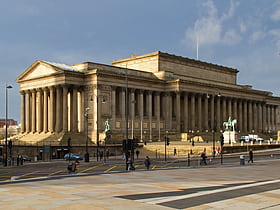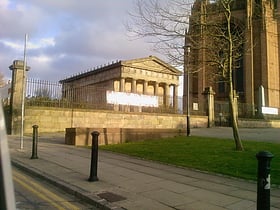Liverpool: Greek Revival Architecture
Places and attractions in the Greek Revival architecture category
Categories
- Church
- Gothic Revival architecture
- Museum
- Park
- Shopping
- Nightlife
- Historical place
- History museum
- Street
- Memorial
- Concerts and shows
- Area
- Shopping centre
- Art museum
- Sacred and religious sites
- Theater
- Monuments and statues
- Sport
- Sport venue
- Cemetery
- Art gallery
- Harbor
- Shopping district
- Specialty museum
- Town
- Dancing
- Greek Revival architecture
- Library
- Music venue
- Music and shows
- Arenas and stadiums
- Gothic architecture
- Science museum
- Golf
- Garden
- City hall
- Outdoor activities
- Tower
- Art Nouveau architecture
- Georgian architecture
- Neighbourhood
- Architecture
- Village
- Universities and schools
- Tunnel
St George's Hall
Neoclassical venue for concerts and events St George's Hall stands as a beacon of neoclassical grandeur in the heart of Liverpool, United Kingdom. This iconic cultural landmark, inaugurated in the mid-19th century, serves as a testament to the city's rich historical and architectural heritage.
The Oratory
Nestled in the heart of Liverpool's cultural landscape, The Oratory stands as a testament to the city's rich architectural heritage. This neoclassical building, designed by the renowned architect John Foster Jr., was constructed in 1829 to serve as a chapel for the...
Cunard Building
Opulent structure with ornate carvings The Cunard Building is a Grade II* listed building in Liverpool, England. It is located at the Pier Head and along with the neighbouring Royal Liver Building and Port of Liverpool Building is one of Liverpool's Three Graces, which line the city's waterfront.
Liverpool Medical Institution
The Liverpool Medical Institution is a historic medical organisation based in Liverpool, United Kingdom. Its building on the corner of Mount Pleasant and Hope Street was opened in 1837, but the site has been used as a medical library since 1779.
The Lyceum
The Lyceum is a Neoclassical Grade II* listed building located on Bold Street, Liverpool. It was constructed in 1802 as a news-room and England's first subscription library and later became a gentleman's club. After the club relocated in 1952 the building was left unoccupied for many years, eventually falling into a state of disrepair.
Map





